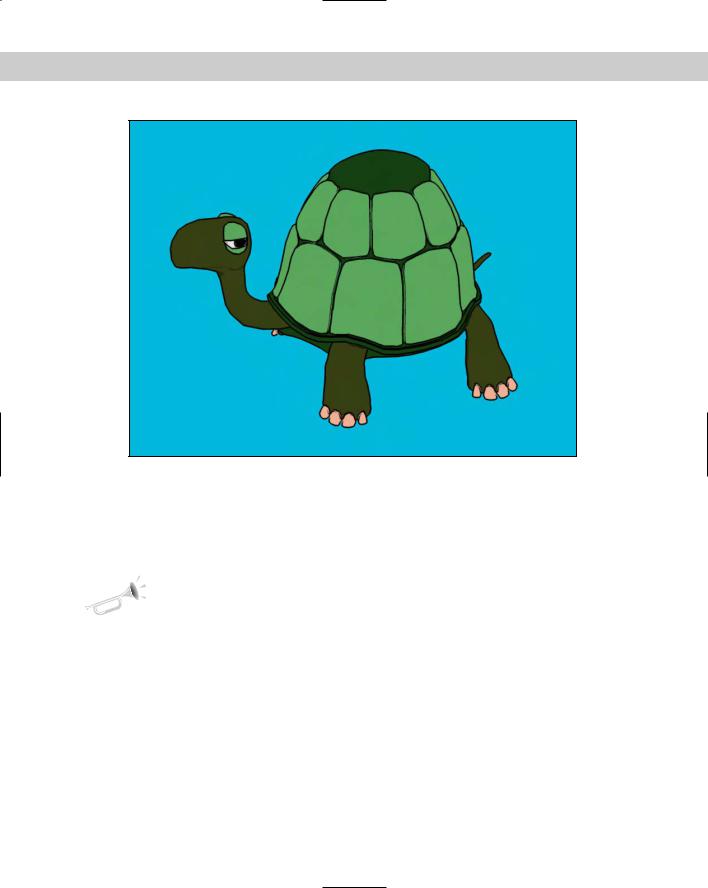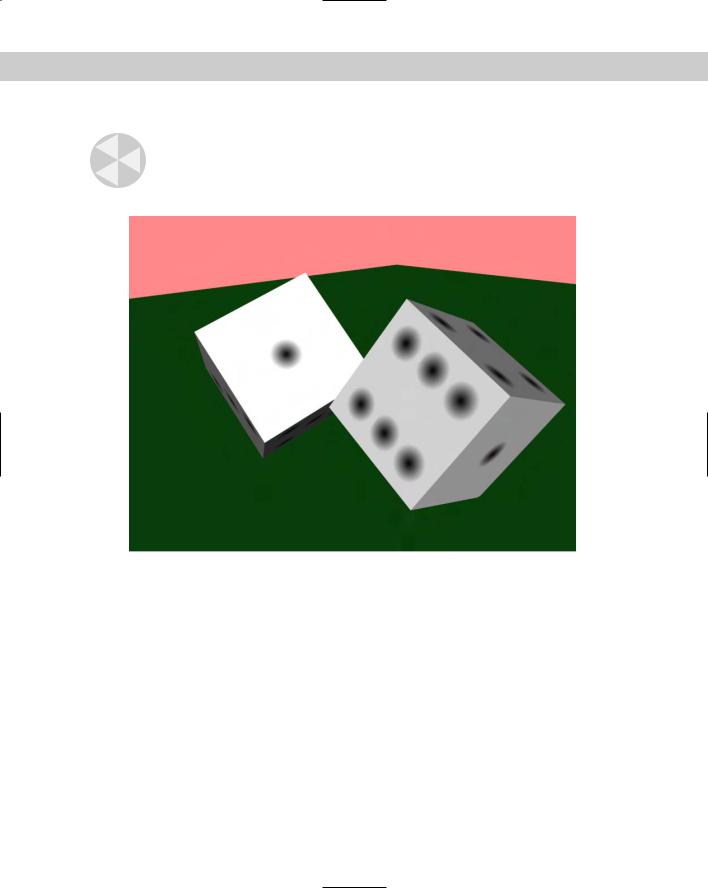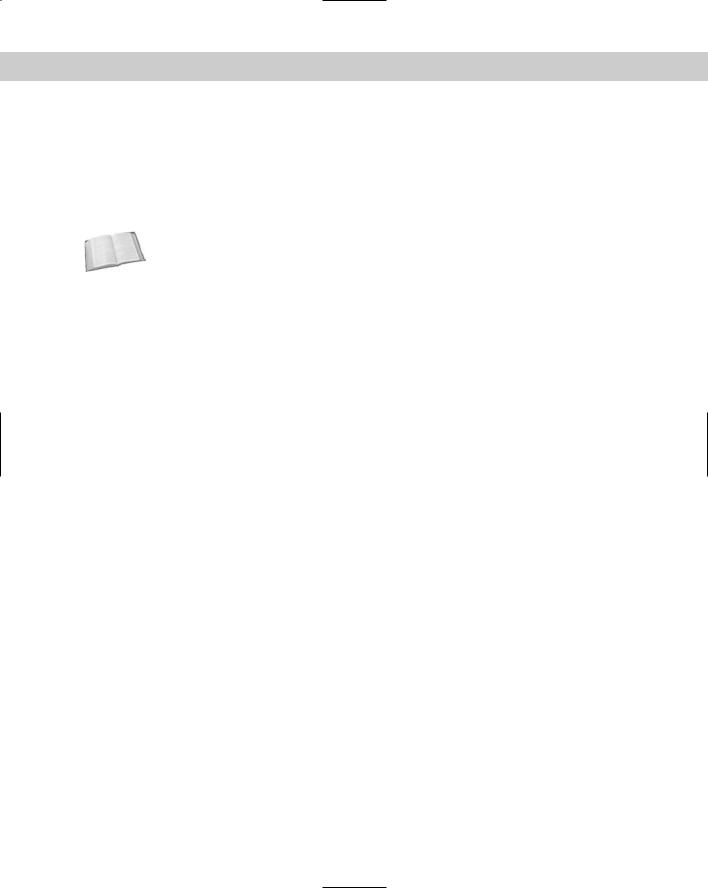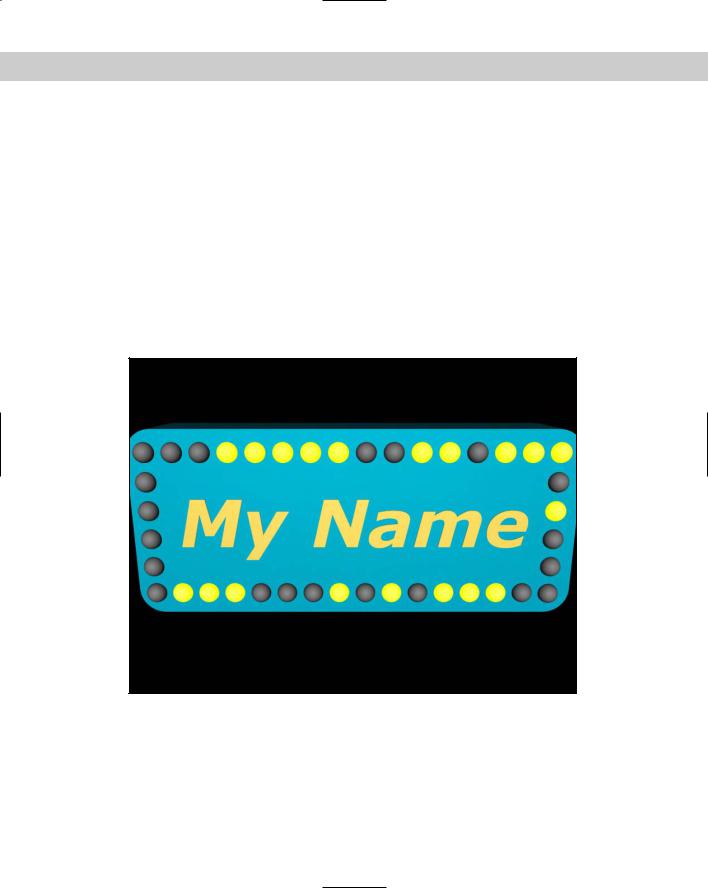
- •Preface
- •About This Book
- •Acknowledgments
- •Contents at a Glance
- •Contents
- •Relaxing at the Beach
- •Dressing the Scene
- •Animating Motion
- •Rendering the Final Animation
- •Summary
- •The Interface Elements
- •Using the Menus
- •Using the Toolbars
- •Using the Viewports
- •Using the Command Panel
- •Using the Lower Interface Bar Controls
- •Interacting with the Interface
- •Getting Help
- •Summary
- •Understanding 3D Space
- •Using the Viewport Navigation Controls
- •Configuring the Viewports
- •Working with Viewport Backgrounds
- •Summary
- •Working with Max Scene Files
- •Setting File Preferences
- •Importing and Exporting
- •Referencing External Objects
- •Using the File Utilities
- •Accessing File Information
- •Summary
- •Customizing Modify and Utility Panel Buttons
- •Working with Custom Interfaces
- •Configuring Paths
- •Selecting System Units
- •Setting Preferences
- •Summary
- •Creating Primitive Objects
- •Exploring the Primitive Object Types
- •Summary
- •Selecting Objects
- •Setting Object Properties
- •Hiding and Freezing Objects
- •Using Layers
- •Summary
- •Cloning Objects
- •Understanding Cloning Options
- •Mirroring Objects
- •Cloning over Time
- •Spacing Cloned Objects
- •Creating Arrays of Objects
- •Summary
- •Working with Groups
- •Building Assemblies
- •Building Links between Objects
- •Displaying Links and Hierarchies
- •Working with Linked Objects
- •Summary
- •Using the Schematic View Window
- •Working with Hierarchies
- •Setting Schematic View Preferences
- •Using List Views
- •Summary
- •Working with the Transformation Tools
- •Using Pivot Points
- •Using the Align Commands
- •Using Grids
- •Using Snap Options
- •Summary
- •Exploring the Modifier Stack
- •Exploring Modifier Types
- •Summary
- •Exploring the Modeling Types
- •Working with Subobjects
- •Modeling Helpers
- •Summary
- •Drawing in 2D
- •Editing Splines
- •Using Spline Modifiers
- •Summary
- •Creating Editable Mesh and Poly Objects
- •Editing Mesh Objects
- •Editing Poly Objects
- •Using Mesh Editing Modifiers
- •Summary
- •Introducing Patch Grids
- •Editing Patches
- •Using Modifiers on Patch Objects
- •Summary
- •Creating NURBS Curves and Surfaces
- •Editing NURBS
- •Working with NURBS
- •Summary
- •Morphing Objects
- •Creating Conform Objects
- •Creating a ShapeMerge Object
- •Creating a Terrain Object
- •Using the Mesher Object
- •Working with BlobMesh Objects
- •Creating a Scatter Object
- •Creating Connect Objects
- •Modeling with Boolean Objects
- •Creating a Loft Object
- •Summary
- •Understanding the Various Particle Systems
- •Creating a Particle System
- •Using the Spray and Snow Particle Systems
- •Using the Super Spray Particle System
- •Using the Blizzard Particle System
- •Using the PArray Particle System
- •Using the PCloud Particle System
- •Using Particle System Maps
- •Controlling Particles with Particle Flow
- •Summary
- •Understanding Material Properties
- •Working with the Material Editor
- •Using the Material/Map Browser
- •Using the Material/Map Navigator
- •Summary
- •Using the Standard Material
- •Using Shading Types
- •Accessing Other Parameters
- •Using External Tools
- •Summary
- •Using Compound Materials
- •Using Raytrace Materials
- •Using the Matte/Shadow Material
- •Using the DirectX 9 Shader
- •Applying Multiple Materials
- •Material Modifiers
- •Summary
- •Understanding Maps
- •Understanding Material Map Types
- •Using the Maps Rollout
- •Using the Map Path Utility
- •Using Map Instances
- •Summary
- •Mapping Modifiers
- •Using the Unwrap UVW modifier
- •Summary
- •Working with Cameras
- •Setting Camera Parameters
- •Summary
- •Using the Camera Tracker Utility
- •Summary
- •Using Multi-Pass Cameras
- •Creating Multi-Pass Camera Effects
- •Summary
- •Understanding the Basics of Lighting
- •Getting to Know the Light Types
- •Creating and Positioning Light Objects
- •Viewing a Scene from a Light
- •Altering Light Parameters
- •Working with Photometric Lights
- •Using the Sunlight and Daylight Systems
- •Using Volume Lights
- •Summary
- •Selecting Advanced Lighting
- •Using Local Advanced Lighting Settings
- •Tutorial: Excluding objects from light tracing
- •Summary
- •Understanding Radiosity
- •Using Local and Global Advanced Lighting Settings
- •Working with Advanced Lighting Materials
- •Using Lighting Analysis
- •Summary
- •Using the Time Controls
- •Working with Keys
- •Using the Track Bar
- •Viewing and Editing Key Values
- •Using the Motion Panel
- •Using Ghosting
- •Animating Objects
- •Working with Previews
- •Wiring Parameters
- •Animation Modifiers
- •Summary
- •Understanding Controller Types
- •Assigning Controllers
- •Setting Default Controllers
- •Examining the Various Controllers
- •Summary
- •Working with Expressions in Spinners
- •Understanding the Expression Controller Interface
- •Understanding Expression Elements
- •Using Expression Controllers
- •Summary
- •Learning the Track View Interface
- •Working with Keys
- •Editing Time
- •Editing Curves
- •Filtering Tracks
- •Working with Controllers
- •Synchronizing to a Sound Track
- •Summary
- •Understanding Your Character
- •Building Bodies
- •Summary
- •Building a Bones System
- •Using the Bone Tools
- •Using the Skin Modifier
- •Summary
- •Creating Characters
- •Working with Characters
- •Using Character Animation Techniques
- •Summary
- •Forward versus Inverse Kinematics
- •Creating an Inverse Kinematics System
- •Using the Various Inverse Kinematics Methods
- •Summary
- •Creating and Binding Space Warps
- •Understanding Space Warp Types
- •Combining Particle Systems with Space Warps
- •Summary
- •Understanding Dynamics
- •Using Dynamic Objects
- •Defining Dynamic Material Properties
- •Using Dynamic Space Warps
- •Using the Dynamics Utility
- •Using the Flex Modifier
- •Summary
- •Using reactor
- •Using reactor Collections
- •Creating reactor Objects
- •Calculating and Previewing a Simulation
- •Constraining Objects
- •reactor Troubleshooting
- •Summary
- •Understanding the Max Renderers
- •Previewing with ActiveShade
- •Render Parameters
- •Rendering Preferences
- •Creating VUE Files
- •Using the Rendered Frame Window
- •Using the RAM Player
- •Reviewing the Render Types
- •Using Command-Line Rendering
- •Creating Panoramic Images
- •Getting Printer Help
- •Creating an Environment
- •Summary
- •Creating Atmospheric Effects
- •Using the Fire Effect
- •Using the Fog Effect
- •Summary
- •Using Render Elements
- •Adding Render Effects
- •Creating Lens Effects
- •Using Other Render Effects
- •Summary
- •Using Raytrace Materials
- •Using a Raytrace Map
- •Enabling mental ray
- •Summary
- •Understanding Network Rendering
- •Network Requirements
- •Setting up a Network Rendering System
- •Starting the Network Rendering System
- •Configuring the Network Manager and Servers
- •Logging Errors
- •Using the Monitor
- •Setting up Batch Rendering
- •Summary
- •Compositing with Photoshop
- •Video Editing with Premiere
- •Video Compositing with After Effects
- •Introducing Combustion
- •Using Other Compositing Solutions
- •Summary
- •Completing Post-Production with the Video Post Interface
- •Working with Sequences
- •Adding and Editing Events
- •Working with Ranges
- •Working with Lens Effects Filters
- •Summary
- •What Is MAXScript?
- •MAXScript Tools
- •Setting MAXScript Preferences
- •Types of Scripts
- •Writing Your Own MAXScripts
- •Learning the Visual MAXScript Editor Interface
- •Laying Out a Rollout
- •Summary
- •Working with Plug-Ins
- •Locating Plug-Ins
- •Summary
- •Low-Res Modeling
- •Using Channels
- •Using Vertex Colors
- •Rendering to a Texture
- •Summary
- •Max and Architecture
- •Using AEC Objects
- •Using Architectural materials
- •Summary
- •Tutorial: Creating Icy Geometry with BlobMesh
- •Tutorial: Using Caustic Photons to Create a Disco Ball
- •Summary
- •mental ray Rendering System
- •Particle Flow
- •reactor 2.0
- •Schematic View
- •BlobMesh
- •Spline and Patch Features
- •Import and Export
- •Shell Modifier
- •Vertex Paint and Channel Info
- •Architectural Primitives and Materials
- •Minor Improvements
- •Choosing an Operating System
- •Hardware Requirements
- •Installing 3ds max 6
- •Authorizing the Software
- •Setting the Display Driver
- •Updating Max
- •Moving Max to Another Computer
- •Using Keyboard Shortcuts
- •Using the Hotkey Map
- •Main Interface Shortcuts
- •Dialog Box Shortcuts
- •Miscellaneous Shortcuts
- •System Requirements
- •Using the CDs with Windows
- •What’s on the CDs
- •Troubleshooting
- •Index

Chapter 21 Creating Advanced Multi-Layer Materials |
597 |
Figure 21-9: Cartooning made easy with the Ink ‘n’ Paint material
Using the DirectX 9 Shader
The Material Editor includes support for DirectX 9 shaders using the DirectX 9 Shader material. These shaders are saved as .fx files and will be available only if the Direct3D display driver is enabled.
New |
Support for DirectX 9 shaders in new in 3ds max 6. |
Feature |
|
In the 3dsmax6/maps/fx directory are several example DirectX 9 shaders. You can load these example shaders using the button in the DirectX 9 Shader rollout. The available parameters are different for each shader.
Applying Multiple Materials
Most complex models are divided into multiple parts, each distinguished by the material type that is applied to it. For example, a car model would be separated into windows, tires, and the body, so that each part could have a unique material applied to it.

598 Part IV Materials and Maps
Using material IDs
You may sometimes want to apply multiple materials to a single part. Selecting subobject areas and using material IDs can help you accomplish this task.
Many of the standard primitives have material IDs automatically assigned — spheres get a single material ID, whereas boxes get six (one for each side) and cylinders get three (one for the cylinder and one for each end cap). In addition to the standard primitives, you can assign material IDs to Editable Mesh objects. You can also assign these material IDs to any object or subobject using the Material modifier. These material IDs correspond to the various materials specified in the Multi/Sub-Object material.
Note Don’t confuse these material IDs with the material effect IDs, which are selected using the Material Effect flyout buttons under the sample slots. Material IDs are used only with the Multi/Sub-Object material type, whereas the effect IDs are used with the Render Effects and Video Post dialog boxes for adding effects such as glows to a material.
Tutorial: Mapping die faces
As an example of mapping multiple materials to a single object, consider a die. Splitting the cube object that makes up the die into several different parts wouldn’t make sense, so we’ll use the Multi/Sub-Object material instead.
To create a die model, follow these steps:
1.Open the Pair of dice.max file from the Chap 21 directory on the CD-ROM.
This file contains two simple cube primitives that represent a pair of dice. I also used Adobe Photoshop and created six images with the dots of a die on them. All of these images are the same size.
2.Open the Material Editor, and select the first sample slot. Name the material Die Faces, and click the Type button. Select the Multi/Sub-Object material from the Material/Map Browser. In the dialog box that opens, select to discard the current map and click OK.
3.In the Multi/Sub-Object Basic Parameters rollout, click the Set Number button and enter a value of 6.
4.Name the first material face 1, and click the material button to open the parameter rollouts for the first material. Then click the map button to the right of the Diffuse color swatch to open the Material/Map Browser, and double-click the Bitmap map. In the Select Bitmap Image File dialog box, choose the dieface1.tif image from the Chap 21 directory on the CD-ROM and click Open.
5.Back in the Material Editor, click the Go to Parent button twice to return to the Multi/Sub-Object Basic Parameters rollout and repeat Step 4 for each of the die faces.
6.When the Multi/Sub-Object material is defined, select the cube object and click the Assign Material to Selection button.
Note |
Because the cube object used in this example is a box primitive, we didn’t need to assign the |
|
material IDs to different subobject selections. The box primitive automatically assigned a dif- |
|
ferent material ID to each face of the cube. When material IDs do need to be assigned, you |
|
can specify them in the Surface Properties rollout for editable meshes. |

Chapter 21 Creating Advanced Multi-Layer Materials |
599 |
Figure 21-10 shows a rendered image of two dice being rolled.
Caution |
The Multi/Sub-Object material is not visible in the viewport and can be seen only in the ren- |
||
|
|
dered image. You can use the ActiveShade window to view the results before rendering the |
|
|
|
final image. |
|
|
|
|
|
|
|
|
|
Figure 21-10: These dice have different bitmaps applied to each face.
Using the Clean MultiMaterial utility
All compound materials have submaterials that are used to add layers of detail to the material, but if these submaterials aren’t used they can take up memory and disk space. You can locate and eliminate unused submaterials in the scene using the Clean MultiMaterial utility. This utility can be accessed from the Utility panel or from the Utilities menu in the Material Editor. For example, if you create a Multi/Sub-Object material with seven submaterials, but later as you are modeling find that you need only five, two submaterials are not needed and can be cleaned.
Clicking the Find All button finds all submaterials that aren’t used and presents them in a list where you can select the ones to clean.

600 Part IV Materials and Maps
Material Modifiers
Of the many available modifiers, most modifiers change the geometry of an object, but several work specifically with materials and maps, including the Material, MaterialByElement, UVW Map, UVW XForm, Unwrap UVW, and Vertex Paint modifiers. In this section, you get a chance to use several material-specific modifiers in a variety of tutorials. The Surface modifiers set includes several modifiers for working with materials.
Cross- |
Find out more about the modifiers that apply to maps in Chapter 22, “Adding Material Details |
Reference |
with Maps.” Another common texture-applying technique uses the Vertex Paint modifier, |
|
|
|
which is covered in Chapter 50, “Max and Games.” |
Material modifier
The Material modifier lets you change the material ID of an object. The only parameter for this modifier is the Material ID. When you select a subobject and apply this modifier, the material ID is applied only to the subobject selection. This modifier is used in conjunction with the Multi/Sub-Object Material type to create a single object with multiple materials.
Material By Element modifier
The Material By Element modifier enables you to change material IDs randomly. You can apply this modifier to an object with several elements, such as a group of spheres attached as a single mesh object. The object needs to have the Multi/Sub-Object material applied to it.
The parameters for this modifier can be set to assign material IDs randomly with the Random Distribution option, or according to a desired Frequency. The ID Count is the minimum number of material IDs to use. You can specify the percentage of each ID to use in the fields under the List Frequency option. The Seed option alters the randomness of the materials.
Tutorial: Creating random marquee lights with the MaterialByElement modifier
The MaterialByElement modifier enables you to change material IDs randomly. In this tutorial, we reproduce the effect of lights randomly turning a marquee on and off by using the Multi/Sub-Object material together with the MaterialByElement modifier.
To create a randomly lighted marquee, follow these steps:
1.Open the Marquee Lights.max file from the Chap 21 directory on the CD-ROM.
This file includes some text displayed on a rectangular object surrounded by spheres that represent lights.
2.Open the Material Editor, and select the first sample slot. Then click the Type button, and select the Multi/Sub-Object material from the Material/Map Browser. Select to discard the current material, and click OK. Give the material the name Random Lights.

Chapter 21 Creating Advanced Multi-Layer Materials |
601 |
3.In the Multi/Sub-Object Basic Parameters rollout, click the Set Number button and change its value to 2. Then click the Material 1 button, and in the Material name field, give the material the name Light On. Set the Diffuse color to yellow and SelfIllumination to yellow. Then click the Go Forward to Sibling button to access the second material.
4.Name the second material Light Off, and select a gray Diffuse color. Then click the Go to Parent button to return to the Multi/Sub-Object material.
5.Select all the spheres, and click the Assign Material to Selection button to assign the material to the spheres.
6.With all the spheres selected, open the Modify panel and select the MaterialByElement modifier from the Modifier List drop-down list. In the Parameters rollout, select the Random Distribution option and set the ID Count to 2.
Figure 21-11 shows the marquee with its random lights. (I’ve always wanted to see my name in lights!)
Figure 21-11: This marquee is randomly lighted, thanks to the MaterialByElement modifier.
